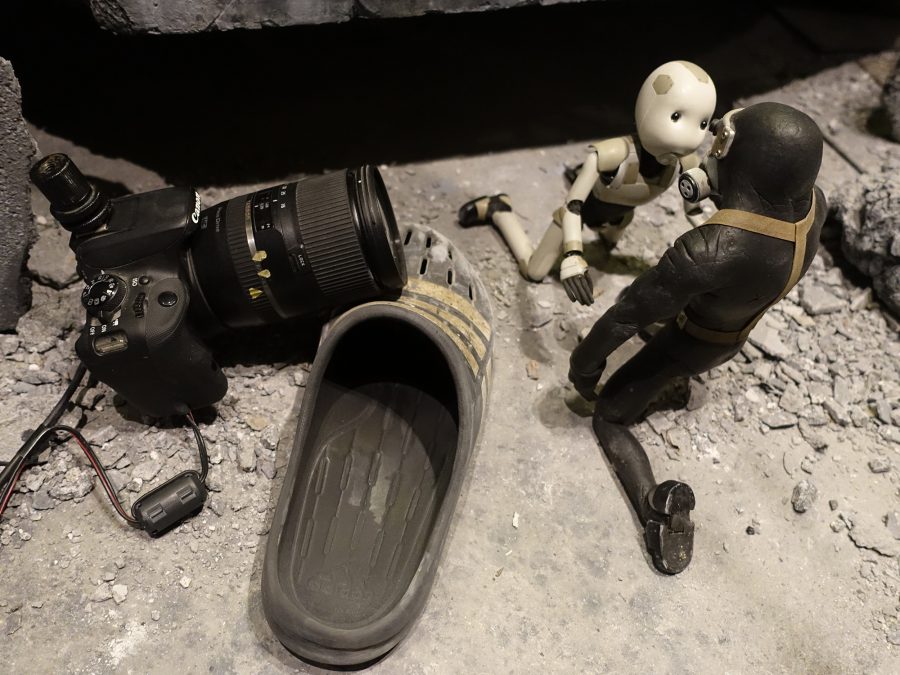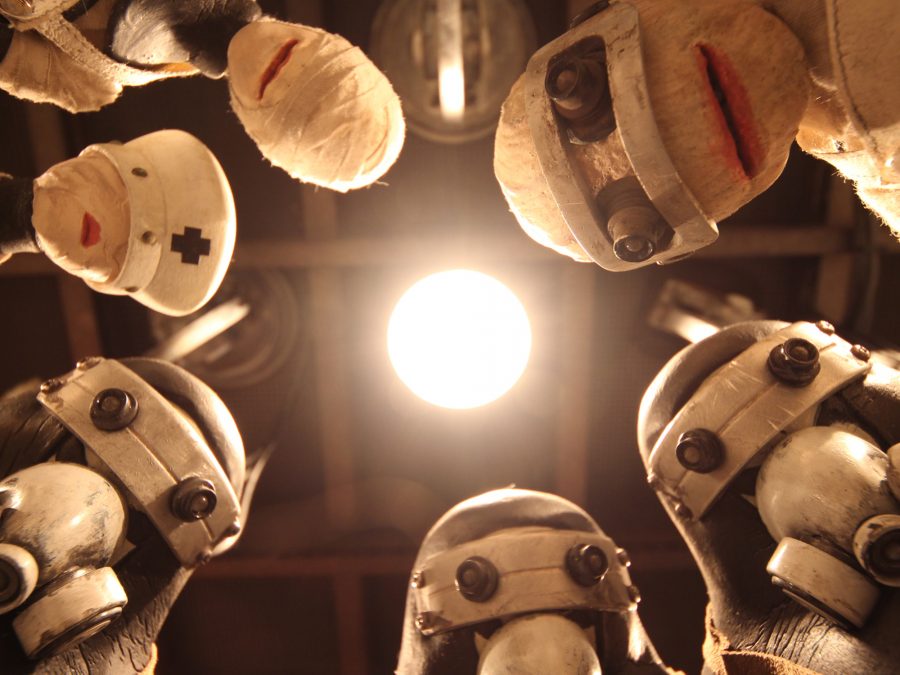Made over the course of 7 years, adapting Takehide Hori’s short film of the same name, Junk Head is a grimy, Švankmajer-esque spelunking into an absurd world where fussy middle managers and bored shift workers coexist with monstrous fleshy spider-creatures and other demonic entities. Seeing the grotesque, imaginative creature design and the scale of it you might not guess that, before the short film that was expanded into the feature, director Hori had never worked in animation before, or filmmaking.
Not only that, he handled nearly every aspect of production himself: building the sets, designing and building the puppets, composing the score, voicing the guttural otherworldly grunts of its funny little characters as well as animating them. After playing festivals internationally including Fantasia, Junk Head earned praise from Guillermo del Toro, calling it a “one-man band work of deranged brilliance”. We spoke to Mori about his DIY approach, working on a budget and how theme park interior decorating translates to filmmaking.
LWLies: What’s it like managing an animation production pipeline, where you’re working on nearly every aspect of it?
Hori: Basically, I had no idea about animation or filmmaking, I had no experience whatsoever. But basically what happened was, you know when you were a child on the corner of your textbook, you draw a little cartoon and then you just flip the pages, you can move the cartoon? So I thought, “Okay, animation is kind of like that.” So I thought, “Well, it should be fairly easy, or that’s something that I could do if I wanted to.” That was my starting point.
Were there any skills that you had to learn while you were in the process of making Junk Head, or did you go in ready?
It was pretty much all on the job. I was creating art, I was an artist beforehand, I was doing arts like drawings, paintings, and also creating dolls. So I was used to creating 3D dolls, but I never moved them. Or again, filmmaking, that was something I’d never done before. So, I learned as I went along. So when something was necessary, I looked up on the internet, or I read a book and I had to study on the spot.
I read that you have a background in theme park interior decoration, how did that influence your approach to the film?
It influenced pretty much everything. If there’s something like, say, Disneyland, when you want to have a kind of aging effect, you have to treat the surfaces. So that skill, I was able to adapt pretty much everything to that 1/6 scale for my creation. I always wanted to become an artist, and I was doing drawings, paintings, and was creating dolls. So, when I was 40 years old, I decided I want to make a movie, and I used everything that I had learned until that point to make it. So, not just the actual artistic creative skills, but also managing people.
How did you go about building the sets?
So, in Junk Head, pretty much everything happens in the subterranean world, loads of corridors and pathways. I had to be as economical and effective as I could be. So, with a corridor, you can actually reuse the same corridor over and over again, walls or ceilings too.
So I wanted to make it bigger, obviously, in terms of scale, but what I did was I thought about the timeframe and the budget, then calculated the scale of the actual set, this is what I could do within that particular budget and the timeframe. So that’s why some of the dolls don’t have eyes, for example.
The set that I probably worked the hardest on was about halfway through the film, the set of the Valve Village, the one looking like a factory. I wanted to create something really elaborate, so it took me six months to actually create that set of that village. I think it’s my favourite, I worked really hard on that.

You’ve mentioned doing drawings and paintings before, so that made me wonder, what drew you to stop-motion animation as a medium to work with?
It was all my misunderstanding, because stop-motion looked really easy, I thought. So everything started from my misunderstanding.
…and I imagine you learned it wasn’t so easy!
[Laughs] Yes, but then again, please understand my point of view. I’m not really great at computers or graphics, and you have to learn about software, you have to learn about computers. I thought my brain doesn’t have that kind of capacity. But whereas the stop-motion animation, all you have to do is that you create it all, you move it, take a shot, easy. How wrong was I?
Were there any key films you had in mind when you set out to make Junk Head?
I took influence from all the movies I’d seen, I must say, but I love sci-fi movies. So when I made this Junk Head, I think my biggest influence would be Alien. And also I think Hellraiser is British, right? I was very inspired by that film.
Yeah, Clive Barker’s from round here! Were there any stop-motion studios you were looking at while you were learning how to make the film, perhaps as a sort of guide on what you wanted to do and what you didn’t want to do?
It might not sound quite right if I said this, but I wasn’t interested in stop-motion films at all before, until I started making Junk Head! But what I was thinking is I want to create something that’s close, as close as possible to a live action movie. So what I was looking at was Jurassic Park, the special effects in something like that was what I had in mind.
It’s funny that you say that, because it did remind me a lot of the work of Phil Tippett, who worked on Jurassic Park. Feels all connected in this funny way.
I actually spoke to Phil Tippett recently, and so his new film, Mad God, was released in Japan quite recently, actually. And yes, I do see the similarity with his style, in terms of creativity or visuals, yes. So it’s quite interesting that you mentioned him. Phil told me that he saw Junk Head, and he said that we might have born from the same egg, and I feel so close to you creatively. I was so glad to hear that.
That sort of brings me back to the puppets, they have some wonderfully creepy designs. Were there any you were particularly fond of?
I like the main character, because his body changes so many times, and I think that’s quite unique in any animation, the metamorphosis of the main character. He has the same personal traits all the way through, even though he changes his shapes, and obviously I wanted the audience to feel that he’s the same person. So I think, from a creative perspective, I think the main character is my favourite to work on.
You were across a lot of this, but you were working with a very small crew as well, and I was wondering how you got in touch with people, and got them to be part of the movie?
So, I created that first 30-minute short film, completely on my own. But as I went along, I was writing the process on my blog, and also I was tweeting everything.. So, when I moved onto this feature version, I didn’t have any budget to advertise to hire people. So I did it on Twitter. But unfortunately, I had this budget for the feature film version, but that’s for the production. So I made it clear that, all right, we can’t pay you much, but everybody worked so hard and did great jobs. And so that’s why I’m doing most of the voices myself, that’s purely for the budget!

You’ve told me about some skills you’ve brought into the film like making the dolls, set decorating and making comics. Did you have any experience in making music before?
[Laughs] Sorry, I shouldn’t… Sorry, God, but it’s so funny. I don’t really listen to music. Music isn’t my hobby, I had never made a single note at all before, but the music software, they are relatively easy to use. So I thought, “Well, okay, I could make a little bit of effort and probably I could do it.” So, it was random, I did it randomly, and I’m so glad that it worked.
You said you’re working on sequels – is there anything you’re going to try to do something differently during production?
So for this one, all the dolls were made by hand, from clay and other materials, every single one. But now since 3D printers are so much cheaper, I started using one for Junk Head 2. So I think that’s the biggest change, so with all the characters, I’m going to use my computer to model it, and just use 3D printer to create the actual dolls, so I think that’s the major change. [At this point Mori pulls out an unpainted puppet] And this doll, I made with my computer and a 3D printer.
But again for Junk Head 2, I have to study as I go along, but I also want to use more graphics, computer graphics, I want to use that to make it bigger in scale. Even going digital you can use analog techniques within this world, and there’s so much potential there. As I told you, I love sci-fi movies. And as a genre, people associate sci-fi with Hollywood, with big budgets. And compared to these great Hollywood films, my budget is tiny, tiny, tiny. But I don’t think you need a big budget to create something different, something exciting.
Junk Head releases in UK cinemas on 24 April 2023.
The post Takehide Hori: ‘Everything started from my misunderstanding’ appeared first on Little White Lies.
from Little White Lies https://ift.tt/w7S1kvQ
via IFTTT

0 Comments